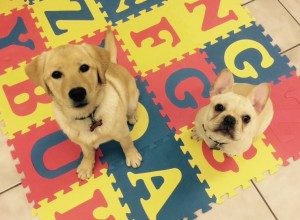 Did you know that the period of 7-16 weeks of age is crucial to your puppy’s proper development? Extensive socialization during this period may be the most important thing you can do for your puppy!
Did you know that the period of 7-16 weeks of age is crucial to your puppy’s proper development? Extensive socialization during this period may be the most important thing you can do for your puppy!
What is socialization?
Dogs aren’t born loving and trusting people. They learn it. Most adult animals are naturally suspicious of anything unfamiliar. Young animals, however, have a period of openness and curiosity as they how their world works. During this “critical socialization window” puppies learn to accept the sites, sounds, and people in their environment. It’s critically important that they have a wide variety of safe positive experiences with people, sights, sounds, and environments during this time.
Why is it so important to socialize my puppy?
Poor socialization poses a huge threat to your dog’s well-being. Shelters report that behavior problems have become the number one cause of pet relinquishment. Thousands of families each year relinquish dogs to shelters due to behavior problems. Most of these problems could have been easily prevented by proper socialization and a bit of early training. Reasons to socialize include:
- Balanced Personality: Well-socialized dogs are more comfortable and friendly in different situations.
- Preventing Aggression: Objects, people, places, and noises a dog is not socialized to can create fear and/or aggression. Dogs isolated during the optimal socialization period will encounter many new things as adults that can cause behavior problems. While people offer a wide variety of explanations for the behavior of dogs that are fearful or aggressive, the vast majority are simply under-socialized.
- Quality Healthcare: Poorly socialized dogs can be difficult (even dangerous) to handle. Regardless of your veterinarian’s skills, it is difficult to deliver optimal care to a fearful or aggressive dog.
- No Do-Overs: The optimal socialization window begins closing quickly. Dogs can still be socialized afterwards, but it requires much more work. You cannot procrastinate with socialization!
What does good socialization look like?
Give your puppy the widest possible variety of positive experiences. You want to teach him, “New is good. New won’t hurt me. I shouldn’t be scared of New.”
- Saftey First: Until your puppy is fully vaccinated, it’s safest to avoid areas that might be frequented by unvaccinated dogs. Dog parks or even parks with lots of people walking their dogs are out. Shopping centers are great, but avoid those with pet related businesses.
- People: Expose your puppy to people of all ages, shapes, sizes, and races. Anything that makes a person move differently (bikes, roller blades, wheel chairs, crutches, a limp, etc.) is good for your puppy to encounter. So is anything that makes a face look different (hats, hoods, sunglasses, scarves, etc.) Toddlers and elderly people are particularly important for puppies to encounter if they aren’t part of your daily life.
- Sounds: Expose your puppy to a wide varity of sounds like traffic, heavy machinery, the vacuum, grocery carts, etc.
- Surfaces: Teach your puppy to climb on things and make sure that they have good experiences with grass, gravel, wood, conrete, the table at the vet’s office, etc.
- Let Your Puppy Set the Pace: Never force or even coax your puppy to approach something when he doesn’t want to. He’ll overcome his shyness much more quickly if he can approach on his own terms.
- Manners Matter: While it’s good for your puppy to meet a large number of people, it’s also important for him to learn to ignore people and other dogs. We don’t want puppies being magnetized to every person and dog that they see in public. When you’re out in public, your puppy should be focused on you most of the time and ignoring most people. You should keep your pup close to you when first encountering new people and only let them say hello with persmission.
Socialization and problem prevention at home
Socializing a puppy also means teaching him to accept and even love things that aren’t necessarily natural for dogs to tolerate:
- Food Bowl Exercises: Dogs don’t generally share food and bones, and food guarding is the most common kind of aggression that most dog trainers see. If we start before they are 16 weeks old, however, we can teach them to love giving things up to us.
- Handling and grooming: Puppies usually love being picked up and cuddled, but adult dogs naturally do not. Proper socialization will teach a puppy to allow handling for veterinary care, grooming, or whenever you need it.
- Easy resolution of problems: Genetic predispositions can contribute to a variety of serious behavior problems, but we can often solve these problems easily if we can catch the warning signs in a young puppy. By 5 or 6 months of age, problems like aggression, separation anxiety, and shyness can already take several times as long to address as it would for a puppy under 16 weeks.
